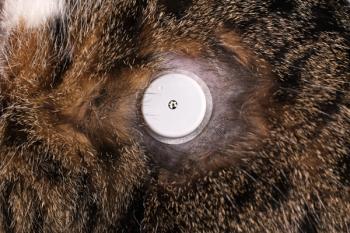
The insulin stopped working? Inconceivable!
This diabetic dilemma is a pain, Highness. Anyone who says differently is selling something.
Photo courtesy of The Princess Bride Ltd.Insulin resistance, according to endocrinologist extraordinaire David Bruyette, DVM, DACVIM, is a condition in which a normal amount of insulin produces a suboptimal biological response-in other words, it fails to control hyperglycemia and its resultant clinical signs. Sometimes the cause can be simple to determine and correct, such as in cases of gingivitis or urinary tract infection; other times it can be near impossible (glucagonoma, anyone?).
The key is to figure out what concurrent conditions are affecting insulin and its receptors in your patient and to treat accordingly so that insulin can be effective. Here are Bruyette's top tips for ferreting out difficult feline and canine insulin resistance cases, with a little help from a classic movie. (Can you guess which one?)
Insulin resistance: You keep using that word …
There is no single insulin dose veterinarians can look to that clearly defines insulin resistance, Bruyette says. But for most uncomplicated cases of diabetes in dogs and cats, glycemia should be controlled using 1.0 U/kg or less of NPH, Lente insulin, or glargine (in cats) twice daily.
Insulin resistance should be suspected if hyperglycemia is noted in the face of insulin dosages exceeding 1.5 U/kg, when insulin dosages greater than 1.5 U/kg are necessary to maintain blood glucose concentrations below 300 mg/dl, or when constant changes in insulin are required to control hyperglycemia. Serum fructosamine concentrations are commonly greater than 500 μmol/L in animals with insulin resistance and can exceed 700 μmol/L if resistance is severe. Don't forget about stress-induced hyperglycemia in cats, Somogyi response or other problems with insulin therapy. Which leads us to the next tip.
You fell victim to one of the classic blunders!
Many times what you're facing isn't a case of insulin resistance but a problem with the insulin itself or administration of the drug, Bruyette says. Before doing a diagnostic workup for insulin resistance, ensure that the following aren't a problem: inactive insulin, an improper insulin syringe, diluted insulin, improper administration technique by the client, inadequate dose, Somogyi response, inadequate frequency of insulin administration, impaired insulin absorption (due to, for example, the presence of subcutaneous edema, scar tissue or local inflammation) and, rarely, anti-insulin antibodies in dogs receiving beef source insulin.
We need to find the man in black
So you've ruled out any problems with insulin therapy and it seems like you do have a true case of insulin resistance. Now what? It's time to search for concurrent disorders. Many disorders can cause insulin resistance, Bruyette says.
If you're treating a dog, factors to consider include severe obesity, use of diabetogenic drugs (glucocorticoids), hyperadrenocorticism, diestrus (in intact females), chronic pancreatitis, renal insufficiency, oral and urinary tract infections, neoplasia, hyperlipidemia and, rarely, anti-insulin antibodies. In cats, common disorders causing insulin resistance include severe obesity, diabetogenic drugs (glucocorticoids), hyperthyroidism, chronic pancreatitis, renal insufficiency, and oral and urinary tract infections. Although rare, don't rule out hyperadrenocorticism and hypersomatotropism (acromegaly). Approximately 80 percent of cats with hyperadrenocorticism and nearly all cats with hypersomatotropism will develop diabetes mellitus.
Vizzini said to go back to the beginning …
Yeah, yeah, Bruyette knows-you've already seen these patients a lot and chances are the client's patience is wearing thin. But it is imperative to start over from the beginning when your insulin therapy isn't working. Get a thorough history, watch the client give insulin, ask where they store it, and what they are feeding the pet. Do a complete physical exam: are there any signs of infection or hormonal disorders?
Design your diagnostic plan ... as ... you ... wish ...
If the history and physical examination are unremarkable, a CBC, serum biochemical profile and urinalysis with bacterial culture should be obtained to further screen for concurrent illness, Bruyette says. Additional tests will depend on results of your initial screening panel.
In dogs, these tests include cPLI (pancreatitis), ACTH stimulation (adrenal function), assessment of thyroid function with TT4 concentration, fT4 concentration if TT4 concentration is less than 1.5 ug/dl, fasting triglycerides and cholesterol concentrations, and serum progesterone concentration in intact female dogs.
In cats, he recommends that additional tests include assessment of thyroid function with TT4 concentration, and fT4 concentration if TT4 concentration is between 2.5 and 4.0 ug/dl, assessment of adrenal function with a dexamethasone suppression test (0.1 mg/kg dexamethasone given intravenously with pre-, four- and eight-hour post-administration cortisol concentrations obtained; this should be carried out only after insulin therapy has been instituted for six to eight weeks to mitigate the effects of poor glycemic control on the hypothalamic-pituitary-adrenal axis), fasting triglycerides and cholesterol concentrations, and serum insulin-like growth factor-1 concentrations in cats with suspected feline hypersomatotropism. (a.k.a. Fezzik syndrome-*wink*).
Still no answer? Inconceivable!
Bruyette continues that additional diagnostics to consider (based on history, physical exam and baseline or other diagnostics) include imaging with abdominal ultrasonography (pancreatitis, neoplasia, adrenal masses or enlargement), thoracic radiography (cardiopulmonary disease, neoplasia), and MRI if you have previously documented pituitary-dependent hyperadrenocorticism or hypersomatotropism.
Once you have an idea of the enemy you are facing in addition to diabetes mellitus, you can set about designing your treatment plan appropriately so your patient can live happily ever after-or at least as comfortably as possible.
Dr. Sarah Wooten graduated from UC Davis School of Veterinary Medicine in 2002. A member of the American Society of Veterinary Journalists, she divides her professional time between private practice at Sheep Draw Veterinary Hospital in Greeley, Colorado, writing articles and filming video content for dvm360 and other media outlets, and speaking on leadership and associate veterinarian issues. In addition to her adventures in veterinary medicine, she also owns a tea tavern in Greeley.
Newsletter
From exam room tips to practice management insights, get trusted veterinary news delivered straight to your inbox—subscribe to dvm360.






